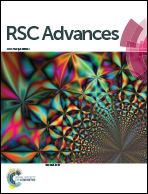Preparation and growth mechanism of one-dimensional NdB6 nanostructures: nanobelts, nanoawls, and nanotubes
Abstract
Three kinds of one-dimensional (1D) neodymium hexaboride (NdB6) nanostructures, including nanobelts, nanoawls, and nanotubes, have been synthesized through a chemical vapor deposition (CVD) process with a self-catalyzed mechanism. For the first time, we report the preparation of NdB6 nanotubes. The morphology and crystalline structure are characterized by X-ray diffraction (XRD), Raman spectroscopy, scanning electron microscopy (SEM), and transmission electron microscopy (TEM). Transmission electron microscopy images show that they have different growth directions: [111], [001], and [110], respectively. In addition, detailed growth mechanisms of the nanobelts, nanoawls, and nanotubes are presented. A droplet induced self-catalyzed mechanism, self-catalyzed with a vapor–solid mechanism, and diffusion limited self-catalyzed mechanism are proposed to explain the growth of nanobelts, nanoawls, and nanotubes, respectively.


 Please wait while we load your content...
Please wait while we load your content...